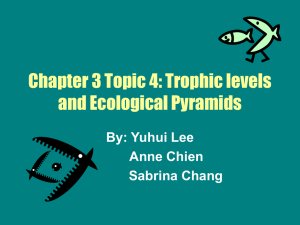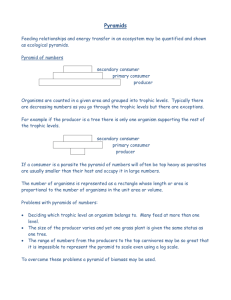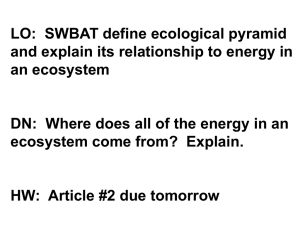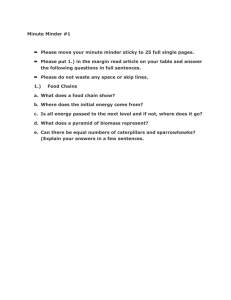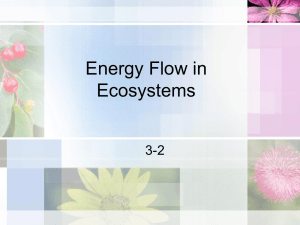LESSON 1: Biomacromolecules
advertisement
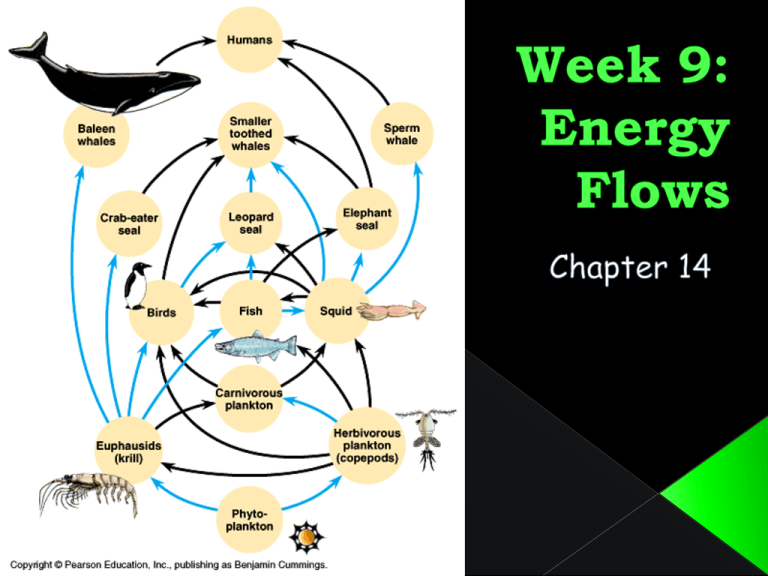
LEARNING OUTCOMES By the end of this week, you should: Be able to describe the ways in which energy flows through ecosystems. Recognise that matter cycles within ecosystems. Understand the key roles of producers and decomposers in ecosystems. Become aware of trophic levels. Give examples of biochemical cycles. 1. Producer 1. Discuss a definition for these 8 words with the person next to you. 2. Check your understanding by choosing the correct definition from the next slide. 2. Consumer 3. Herbivore 4. Detritivore 5. Carnivore 6. Food chain 7. Food web 8. Sun I make my own food using sunlight and raw materials. I obtain my food by eating other living organisms. I only eat plant material. I obtain my food only from animals. I eat dead plant or animal material. I am a simple diagram showing the flow of energy as one organism eats another. I am a more complicated (and more realistic) version of this diagram. I am the original source of energy for all living things. Producers Primary consumers Secondary consumers Tertiary consumers Trophic level 1 Energy can exist in many forms. All ecosystems require an energy source. 2 The energy input into ecosystems is typically the radiant energy of sunlight. 3 Energy flows through an ecosystem and must be continually supplied. 4 Energy is captured and brought into an ecosystem by producers. 5 Producers transform radiant energy to 6 7 7 chemical energy in organic matter. Organisms in an ecosystem can be classified into different trophic levels. 8 Complete Quick-check questions on page 446 – Nature of Biology 1. How do we lose energy to the environment? 2. What is the effect of maintaining a constant body temperature? 1 Not all organisms at one stage are eaten by the stage above. Some energy is used for respiration (to 2 maintain body heat). 3 and for Some energy is used to make heat movement (muscle contraction). 4 5 Some energy is used to produce biomolecules and cells. Some energy is used to transmit nervous 6 impulses. 6 7 Some material is passed as waste. The rule of thumb: the useful chemical energy leaving one trophic level is typically only 10% of the energy entering that level. The amounts of ……………… and ……………… contained in living things always gets less at each stage of a ……………… from ……………… onwards. Biomass is lost as ……………… products and used to produce ……………… in ……………… . This is used for ……………… and to control ……………… . Only a small amount is used for ……………… . waste body temperature respiration food chain growth biomass energy energy plants movement The amounts of biomass and energy contained in living things always gets less at each stage of a food chain from plants onwards. Biomass is lost as waste products and used to produce energy in respiration. This is used for movement and to control body temperature. Only a small amount is used for growth. Food Chains and Webs 1. Where does the energy originate from? 2. What happens to this energy as you go through the food chain? 3. What do the arrows represent? 4. Where is energy lost? Complete the Quick-check questions – page 452 Numbers, Biomass, Energy The population of each organism in a food chain can be shown in a sort of bar chart called a pyramid of numbers. The more organisms there are, the wider the bar. The producer in the food chain always goes at the bottom of the pyramid of numbers. Think about this food chain: clover snail thrush hawk › Clover is a plant and it is the producer in this food chain. Its bar goes at the bottom of the pyramid: Energy is lost to the surroundings as we go from one level to the next, so there are fewer organisms at each level in this food chain. › A lot of clover is needed to support the snail population. › A thrush eats lots of snails, and a hawk eats lots of thrushes, so the population of hawks is very small. Sometimes the pyramid of numbers doesn't look like a pyramid at all. This could happen if the producer is a large plant such as a tree, or if one of the animals is very small. Still, whatever the situation, the producer always goes at the bottom of the pyramid. For example: 1) An oak tree is very large so many insects can feed on it. 2) Fleas are very small and lots of them can feed on a rabbit. Biomass is the mass of living material in an animal or plant. Biomass is made by plants from sunlight energy. It is often measured as the dry mass of biological material in grams. Biomass decreases as a food chain progresses (at each trophic level). A pyramid of biomass gives a rough idea of the amount of biomass passed on at each stage. Shows the amount of energy input at each trophic level in a given area of an ecosystem over an extended period of time (usually one year). The flow of energy is always reduced from one trophic level to the next, so a pyramid of energy is never inverted. stinging nettles caterpillars robin Number Biomass marine plants small fish large fish seals polar bear Number Biomass 1. Complete Quick-check questions page 454 2. Complete the worksheet The Carbon Cycle How did the carbon get into this piece of coal? What would happen if we burnt it? Photosynthesis Respiration Decomposition Detritus Producers Consumers Excretion All the time, a relatively small amount of available carbon is cycled between living things and their environment. 1 All of the main molecules that make up our bodies (carbohydrates, fats, and DNA) are based 2 3 proteins 4 5 on carbon atoms combined with other elements. The amount of carbon on Earth is fixed. Some is 6 found in fossil 7 fuels 7 and is only released when they are burnt. Limestone and chalk contain huge amounts of carbon. 8 2 in air. Found in CO 9 Also dissolved in water. The Nitrogen Cycle Nitrogen-fixation Nitrification Denitrification Decomposition The Water Cycle Precipitation Evaporation Transpiration Percolation Ground water Return flow Surface run-off (Biomagnification) Chemical enters ecosystem and into food chain. 2. If not readily broken down by organisms (ie. it is a persistent chemical), it accumulates in their tissues. 3. It becomes progressively concentrated as it enters organisms at higher trophic levels. 1. Complete the Quick-check questions on page 467 Complete the poster task on biochemical cycles True False – combustion releases carbon dioxide gas False – more is found in marine organisms and limestone rock deposits True False – both animals and plants respire False – they respire and release carbon dioxide True False – scientists think it will cause global warming True True





